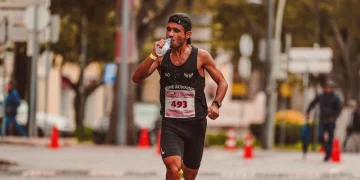So, you decided to start running but don’t know what is right for you? In this blog post, we will describe different types of running and the most popular features of each.
1. Short Distance Running (Sprint)
A sprint is running at the top speed possible, usually just for a short distance. This type of running is a much more vigorous, high-intensity exercise.
Notable sprinters are Usain Bolt, Justin Gatlin, and Johan Blake. Among them, the clear favorite is the multiple World and Olympic champion, world record holder Usain Bolt. Usain Bolt from Jamaica is considered the fastest man on the planet. Bolt set the world record in the 100m (9.58 seconds) and 200m (19.19 seconds) at the World Championships in Berlin in 2009. He is an 8-time Olympic champion and 11-time world champion.
145 athletes in history have already covered the 100m distance in less than 10 seconds.
The classic sprint distances are:
- 100 meters
- 200 meters
- 400 meters
Among the non-standards are the 30 m (school standards), 60 m (indoor competitions), and 300 m.
2. Middle Distance Running
Middle distances are considered less dynamic than sprints, but the final 100 meters can be just as exciting. Often, judges use a photo finish to determine the winner.
The main distances in middle distance running are:
- 800 m
- 1500 m
- 3000 m (hurdles)
Additionally, distances include 600 meters, 1000 meters, a mile (1610 m), and 2000 meters.
Middle-distance running is considered complex since it has an ambiguous distance. On the one hand, the distance is short, but it is too long for an all-out sprint pace. As a result, the distance is usually covered at close to the maximum running speed.
Middle distances athletes often compete in 400 m (sprint) or 5000 m (long run pace)
In this discipline, the best runners are from Ethiopia and Kenya. A well-known athlete in the 800 meters is David Rudisha, a Kenyan. In the 1500 m run, the Algerian runner Taufik Makhloufi is a repeat prize-winner.
3. Long-Distance Running
Distances of 3000 meters or more are considered to be long. Long-distance running competitions are held on a track or the road. 3,000 to 10,000 meters are done in a stadium on a track, and races above 10,000 meters are done on the road and measured in miles, except for marathons.
Olympic distances are:
- 5K
- 6.213 mile 10 K
- 26.1 miles or 42 km 195 meters
Long-distance races have no limits in duration and length.
A well-known marathon runner is Kenyan athlete Dennis Kimetto, who overcame the distance of 26.1 miles in 2 hours 2 minutes 57 seconds. It is worth noting that women are not far behind, and the fastest marathon was run by Paula Radcliffe (Great Britain) with a result of 2 hours 15 minutes 25 seconds.
4. Steeplechase
Steeplechase is the narrowest type of running, which involves only two distances: 2000 m in the arena and 3000 m in the open stadium. The essence of the steeplechase is to overcome the distance, during which there are 5 obstacles, including a pit with water.
During the race, groups are formed, separated by tens of meters. And sometimes, the winner in the hurdle race is half a circle ahead of the pursuers, which equals 200 meters.
The world record for men was set by Qatari runner Saif Saeed Shaheen, who covered the distance in 7:53.63 minutes.
5. Hurdling
Hurdling covers distances that fall into the sprint category. What makes this type of running event different is the presence of obstacles (called hurdles) that athletes must jump over.
The Olympic program includes the following distances:
- Women – 100 m, men – 110 m
- 400 meters
Regardless of distance and gender, all courses have exactly 10 hurdles. So only the distance between the barriers and the height of the obstacle can be changed.
Aris Merritt set the world record for men in the 110 meters hurdles at 12.80 s. Yordanka Donkova holds the women’s 100 meters record at 12.21 s.
6. Relay Race
The relay race is a team discipline that involves passing a baton to your teammate after overcoming a given distance.
The relay race is held over two distances at the Olympic Games, 4 × 100 meters and 4 × 400 meters.
World records are also regulated at distances of:
- 4×200
- 4×800
- 4×1500
There are also mixed and combined relay races: 800+400+200+100 meters and 4×100 hurdles.
Jamaica holds the world record in the 4×100, thanks in large part to Usain Bolt at 36.84 seconds. The United States holds the 4X100 record for women at 40.82 s.
Additional Types of Running
There is a variety of running disciplines that do not fall under the standard classifications. These runs are more suitable for workouts and not for competitions.
- An interval workout involves running straight for X number of meters and then accelerating to a much faster pace.
- Jogging means a leisurely pace over the entire distance. This is suitable for a recovery run pace and distance that doesn’t involve acceleration.
- Rogaining is a team run that involves passing checkpoints along the course. The checkpoints are spaced throughout the distance, which the team must overcome in full force. The number of team members varies, and the last team member fixes the final result.
- Cross-country running covers routes through nature with various elevation changes. Distances range from 1 km to 50 km.
There are a wide variety of running options, and athletes have achieved remarkable results in every one of them. History has repeatedly proven that a predecessor’s record can always be beaten. Yet, even if your goal is not setting new records, it is always good to try new things and discover what kind of running is most suitable for you.






